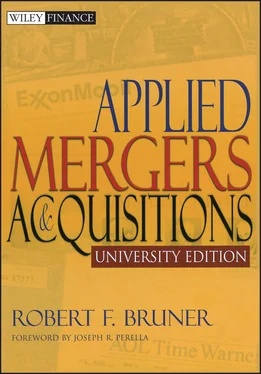This review of the four waves reveals much more about their differences than similarities. What they seem to bear in common is low or falling interest rates, a rising stock market, and an expanding economy. But they differ sharply in industry focus (e.g., oil, banking, utilities, Internet, conglomerate, etc.), in type of transaction (e.g., horizontal, vertical, conglomerate, strategic, or financial), in the presence or absence of hostile bids, in industry breadth, in breadth of deal size, and in the role of large blockbuster deals. Merger activity appears to slow down when the cost of capital increases, as measured by real interest rates. Studies 4 show that M&A activity is countercyclical to bond yields. More generally, merger activity increases with the level of overall economic activity, as measured by nominal GNP; see Golbe and White (1988).
On close examination, there appears to be an industry-based pattern to the waves of M&A activity. The Mergerstat database suggests that in 1998 and 1999 the most active 14 percent of industries accounted for 60 percent of all M&A deal value. In the period 1995 to 1998, financial services accounted for 22 percent of all M&A value. In 1981 to 1984, oil and gas accounted for 25 percent of all transaction value.
EXPLANATIONS OF M&A ACTIVITY
What drives these waves of M&A activity, creating “hot” and “cold” markets for firms? What causes some industries to grow hot and others remain cold? Research lends some speculative answers to these questions. The explanations should be approached with caution since they are not mutually exclusive and more research remains to be done. But these ideas can help the practitioner frame a view about M&A activity, and thus more ably interpret events and opportunities as they appear. While some of these explanations are stronger than others, they all offer a useful perspective on the activity we observe.
The first explanation for M&A activity lies in managerial psychology. Richard Roll (1986) suggested that the urge to merge is driven by pride, or hubris , in the face of considerable evidence that earning supernormal returns from acquisitions is difficult. Roll notes that the negative returns following mergers are well known. Only an irrational belief that your deal will be different could prompt you to strive where others have failed. Popular accounts of particular deals or deal makers would seem to support this view (see, for instance, Bryan Burrough and John Helyar’s classic 1990 account of the RJR Nabisco LBO, Barbarians at the Gate ). The hubris of the rich and famous is a timeless theme, certain to sell books. And it is timeless for a very good reason: we benefit from the reminder that hubris undercuts rational analysis and self-discipline.
But the hubris hypothesis for M&A activity says too much and too little. It says too much in the sense that hubris could be used to explain most business failures. For instance, something like 70 percent of all new businesses fail within three years. Drug companies spend millions of dollars annually most of which hits dead ends. The revolution of digital computing has left countless failed firms in its wake. The odds of success are low in business start-ups, drug discovery, and technological innovation, and it takes an entrepreneur with at least a modicum of hubris to press ahead. We applaud hubris in these cases because it advances the welfare of society through the discovery of new products and markets. Isn’t M&A a discovery process as well? If hubris were to be the dominant explanation for M&A activity, it would need to explain the appearance of merger waves and the clustering of merger activity by industry.
Hubris says too little in that one wishes it had more prescriptive content. It urges us to avoid managerial irrationality, and warns that if we fail to do so, markets will judge accordingly. Through the research work of Kahneman and Tversky (1979, 1984), Thaler (1992), and others, we are gaining a clearer view of the role of behavioral influences in financial decision making. But behavioral finance remains a young field; more research remains to be done. Questions for the analyst include these:
Who are the decision maker and his or her advisers? What, in their background, might suggest a tendency to disregard rational analysis and disciplined thinking? M&A arbitrageurs often develop psychological profiles of the CEOs of companies they follow. Though imperfect, these give hints about the decision maker’s ability or willingness to think critically about M&A proposals and to act in the interests of shareholders.
Is the decision maker isolated or in touch with reality of the M&A situation? One hears about the imperial CEO. Like the fabled emperor who had no clothes, the CEO might have a culture of “yes people” who simply endorse what the CEO proposes.
Does the decision maker operate under a governance system of monitoring and control? One of the benefits of good governance systems is to forestall problems of hubris. Chapter 26discusses dimensions of governance.
A variant on the behavioral theme is the role of mass behavior that produces market bubbles, crashes, and fads. Kelly (1994) likened market movements to swarms of bees and flocks of geese. Others have sought to apply chaos theory to explaining the unpredictable movements in the market; see Gleick (1998). Robert Shiller (1998) discusses fads in financial markets as motive for takeover. He cites psychological literature on group behavior and gambling as parallels to merger fads. A variation on this point is the “I don’t want to be left out” factor for companies who are surrounded by acquisitive competitors. Investment bankers tell interesting anecdotes about “deal frenzy,” a kind of psychological momentum to get a deal done—on almost any terms—after an executive has been working toward the deal for some period of time. Toxvaerd (2002) models merger waves as the result of the attempt by managers to improve the strategic positions of their firms through preemption in the competition for scarce targets. The competitors would prefer to delay and retain the option to acquire. But in constant reference to their competitors, they all snap into action as the result of an industry shock or the release of some decisive bit of information: this produces a stampede to acquire, a type of rational frenzy.
The practical person will find it hard to know what to do with the mania explanation. Chapters 30and 31emphasize the influence of psychological effects on M&A outcomes. Our understanding in this area is still in its infancy. Still, the practitioner seeking to understand M&A activity should ask at least two questions:
1 Does the market, my industry, or my firm seem in the grip of “deal frenzy”?
2 What is the tendency of the “herd” in my industry with respect to M&A? What is the “lead steer” doing?
Both of these questions invite, at best, qualitative answers. Generally, the size of acquisition premiums relative to historical averages will give some sense of whether the deal flow is hot or cold. A close following of speeches, interviews, scuttlebutt, and, above all, M&A actions is the grist from which answers to these questions will be made.
Overvaluation of Stocks and the Asymmetry of Information
Five studies associate the appearance of waves with buoyant capital market conditions: a rising stock market and low or falling interest rates. M&A waves are procyclical; they occur in line with increases in stock prices. 5 There is some disagreement about whether peaks in M&A lead or lag peaks in stock prices. 6 Nelson (1959) suggests that rapid development of a capital market (in countries where it had been previously undeveloped) may spur M&A activity. Golbe and White (1988) argued that merger activity increases when bargains are available, as measured by a low ratio of market value to replacement costs (Tobin’s Q). Recent theories by Shleifer and Vishny (2001) and Rhodes-Kropf and Viswanathan (2003) consider an alternative explanation: that stock markets may overvalue stocks. Managers of firms have their own inside assessments of the intrinsic values of their firms. Because they know more than investors on the outside (economists call this “ information asymmetry ”), these better-informed assessments may vary from the prices in the market. When the prices in the market exceed the insider assessment of value, rational managers can enhance the wealth of their current shareholders by selling stock. Thus, equity issuance will tend to occur when stock prices are high, an idea advanced by Myers and Majluf (1984).
Читать дальше












